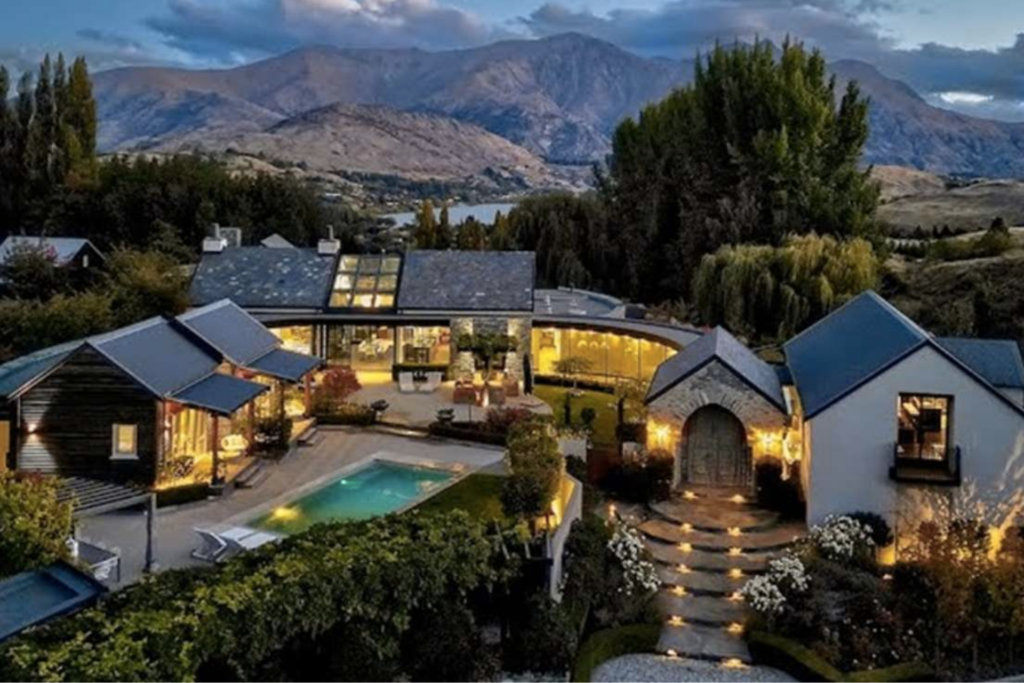
Inside NZ’s Most Expensive Neighbourhood






$20m houses and strict rules around clotheslines
“They’ll have beach parties at Omaha and suddenly work out they have homes together at Millbrook.”
In a region already known for its luxury homes and sky-high prices, Millbrook is viewed by the super-wealthy as a cut above.
Among the high-end properties for sale in the exclusive, semi-gated resort in Queenstown-Lakes is a trophy home at 2 Millvista Lane.
On the open market for the first time since it was built in the mid-2010s, the 810sqm, four-bedroom property sits on 4180sqm of land and is seeking around $20 million.
The house was designed by Haden Emslie Architecture and is a mix of schist stone pavilions, slate, steel and aged larch – with entry doors from Rajasthan, a state in India famous for historic forts and palaces.
It comes with a pool and a separate New York-style loft apartment for guests and boasts amazing mountain and lake views.
The property is up there with the best of the best at Millbrook, according to property sales and development director Ben O’Malley, although another house currently under construction at the resort reportedly has a build cost of around $20m.
OneRoof records also show Millbrook is home to what is likely the country’s most expensive cul de sac.
Ayrburn Ridge, which includes the Coronet Square neighbourhood, has 27 houses and since 2018 12 have sold (including one resale) for a total of almost $58m – the combined CVs on all the properties in the street add up to just under $165m.
Teresa Chapman, from Millbrook Realty, is involved with some of the more recent listings there and says she received an outstanding offer for an Ayrburn Ridge property in March but the owners decided not to sell after falling in love with their house all over again.
That happens sometimes in the resort, she says. A lot of the buyers are already residents, with homeowners often looking to upgrade or move closer to the greens or amenities.
It’s a bit like the “Omaha Shuffle”, a phenomenon referred to by agents in the wealthy beach town north of Auckland where owners move closer and closer to the beach.
Chapman says some people own properties at both Omaha and Millbrook: “They’ll have beach parties at Omaha and suddenly work out they have homes together at Millbrook.”
Millbrook has been in operation for over 30 years and is now a five-star golf and lifestyle retreat, but back in the gold rush days the land grew wheat to feed the miners. It then became a camp for the Wakatipu mounted rifles in the early 1900s, then a hospital for World War I soldiers.
After World War II it reverted to a farm but in 1993 it opened as a lifestyle resort, with investment and support from the Ishii family of Japan whose company still owns the resort.
Chapman thinks sales there often fly under the radar because buyers tend to have an association with Millbrook, which has an extensive database and has waiting lists of people wanting to get into certain neighbourhoods.
“Millbrook does have its own premium,” she says. “Properties that sell in here always seem to be higher than what sells outside of Millbrook, but that’s because we have the amenities here as well – two golf courses, a driving range, health and fitness centre, spa facilities with 10 treatment rooms, four restaurants.”
The historic gold mining town of Arrowtown is next door and the new restaurant and bar facility of Ayrburn (not to be confused with the Ayrburn Ridge cul de sac) is just down below.
O’Malley says Millbrook has design controls, which gives the place its own special character and which is why houses have nods to the early central Otago forms with steep pitched roofs and certain cladding and materials used.
“The concept is more around simple but beautiful forms within a very powerful landscape, rather than ‘look at me’ type houses.”
The rules also mean the clothesline has to be hidden and the heat pump not cause a problem for neighbours, something Chapman calls “nice rules for living”.
O’Malley says a lot of people treat their property as a family heirloom. They might buy them in a family trust and see the property as a multi-generational investment, and some houses are built with a view to different generations coming together, and with room for ski and golf guests as well.
He says earlier homes were more modest but over the last 20 years more substantial homes have been built on large sites.
There is a premium for fairway-fronting sites, and owners get the advantage of the maintenance of the “borrowed landscape” all around being taken care of by someone else.
Owners will always have the advantage of lots of open space because Millbrook has its own planning zone rules under the district plan and has to have 95% open space.
The resort sells bare land, or house and land packages where it builds the house, in small clusters and O’Malley says there are 10-plus years’ worth of stages to come, saying the resort is still expanding in a carefully managed way.
The current housing market has slowed the schedule a little but he says the resort has been through several cycles of the property market and has found that during the tough times, like the GFC and Covid, it continued to trade strongly because of a flight-to-quality mentality.
Around 20 houses are currently under construction. The one which costs close to $20m to build is a private build over two sites. “Nine hundred square metres, slate roof, stone cladding, imported European windows. It’s a very high spec home, fairway-fronting.”
As for Ayrburn Ridge, that’s certainly one of the more exclusive neighbourhoods, O’Malley says, where houses open to Coronet number one, two and three holes.
“There are fairways wrapping right around this neighbourhood and it’s sitting up on an elevated ridge that steps gently down to the north.”
Chapman says in the last two years there have been sales at the resort for $9m, $7.5m, $6.9m and more.
Owners range from families to retirees, and there are nationalities from all over the world who bought before the foreign buyer ban.
There are holiday homes but the permanent resident population has increased since Covid, she says.
“But when we say permanent, a lot of them will be here for four or five months and then they’ll have a quick trip overseas somewhere, or they don’t want to be here for the winter, or they want to be here for the summer golf, or they go to their other holiday homes.”
This post (and images) have been republished with the permission of Oneroof.co.nz



